HomeFeaturesJump Ship
The game formerly known as Hyperspace reannounced for 2024 early access release
Image credit:Keepsake Games
Image credit:Keepsake Games
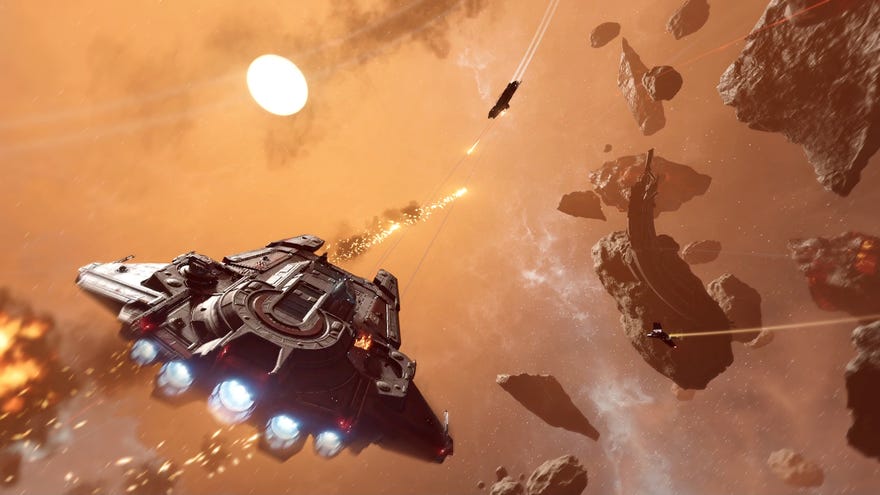
It’s a pretty minor fire, mind you. A combusting deep dish doesn’t place very highly on the list of possible ship emergencies next to, say, your reactor coughing up nuclear rods, or your engines running out of juice because some oaf hooked up too many turrets to the aforesaid reactor. But if you leave the fire unchecked, perhaps because you’re busy disposing of radioactive waste or vengefully unplugging half the point defences, it’ll eventually singe your ship’s health to nothing - insert appropriate Steam achievement pun and/or Klingon proverb. It’s an agreeable little note of idiocy in a game that takes cues from Valve’s timeless anecdote generatorLeft 4 Dead, Sea Of Thieves, FTL and, perhaps most surprisingly, Diablo.
Jump Ship - Official Gameplay Explainer TrailerWatch on YouTube
Jump Ship - Official Gameplay Explainer Trailer

We first covered Jump Ship back in 2020, with a Sin Vega classic majestically subtitled"The Brief Life and Tragical Death of Captain Farts"which, according to the developers themselves, earned Jump Ship a lot of early interest on Discord. The game began life as a side project from Filip Coulianos, one of Hazelight’s founders. It’s since evolved to include a 5-10 person team of industry veterans, with former Mojang business director Daniel Kaplan presiding as Keepsake CEO.
The Diablo comparisons apply exclusively to your ship itself, which is the only part of the game that levels up. You can garb your character in different equipment for limited boosts, but only your vessel undergoes continuous evolution, even as different groups of co-op partners come aboard, polish the furnishings or make a mess of things. “The ship is basically our collective Diablo character,” Coulianos told me during a GDC demo. “We upgrade the components and it persists, so the stuff we upgrade today will stay when we play tomorrow.”
While Keepsake haven’t implemented anything remotely like this as yet, I love the idea of an upgradeable craft that can be transferred between different owners, becoming a legend in its own right within the Jump Ship community. In the shorter term, applying progression exclusively to your ship strikes a balance between the sense-of-investment games now trade (rely?) on, and the immediacy of a game without grinding. “We don’t believe in classes or skill trees or anything like that,” Coulianos adds. “You can unlock armour and stuff like that which has some impact - maybe if you get like, the marine suit or the footsoldier suit, you have a little bit more ammo in your pocket, or if you unlock the engineer suit, you’re going to be able to do repairs for a little bit less resources.
“But we want to keep the fact that you can dynamically switch roles, depending on what’s going on in the ship, and we don’t want to lock down players to do a certain thing. We also kind of want the players to feel like, ‘Hey, I’ve played 50 hours - you’re new, but in the game, we’re still equal’. I think a big pro is that sure, the ship could be level 50, but you as a new player can still contribute when we’re playing together. So there is a little bit of individual progression, but the main thing is the ship.”
Image credit:Keepsake Games
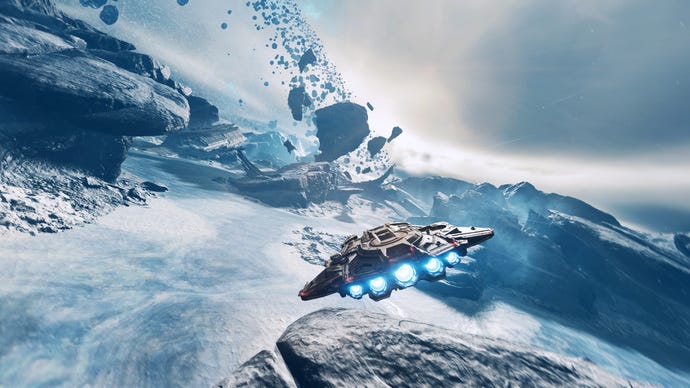
Mission maps themselves are individually designed rather than being generated, each a “5-10 kilometre bubble”, with terrain and hazards and objectives laid out to ensure it’s not just 15 minutes of flying in a straight line. Mission goals often encourage or require some players to leave the ship to plunder or investigate a structure, and much of the drama naturally arises from your noble vessel getting its head kicked in while you’re off enjoying the bracing fresh air or marvelling at the endless void.
Image credit:Keepsake Games
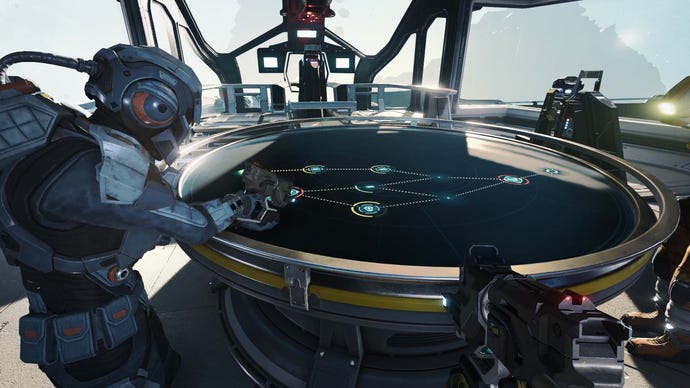
In the case of a mission in which part of the crew must investigate a buried structure, the Away Team might need to toggle jetpacks with shift key and rendezvous with their ship in flight, while it’s dogfighting with robot sentries - thankfully, you’ve got a set of magnetic boots that glue you to the hull when you’re not using your jetpack. Mission difficulties also scale up and down based on the number of players. It’s possible to solo Jump Ship - amongst other things, the game will tactfully reduce the odds of ship system failures during solo voyages, so that you don’t spend the whole time patching up the interior of a sitting duck - though it’s definitely at its best in co-op.
Ship combat is a nice play of scales, given a definition of “nice” that encompasses “nerve-wracking” and “a bit nauseating”. Being a crew member means seeing every movement of the pilot’s thumbs and every little tactical decision or error writ large in the bucking and heaving of the view through the portholes. You probably won’t have time to stop and stare, of course. In a larger engagement, you’ll have your hands full repairing things, including components on the hull exterior, to say nothing of redirecting power and extinguishing fires.
The on-foot combat, meanwhile, is first-person shooting with a dollop of support gadgets, modelled on Left 4 Dead. “One thing [that game] did really well is kind of encourage players to stick together,” Coulianos says. “There could be enemies that lock some players down, and then they need help. We have a lot of gadgets and items like a healing bot that heals everybody within a certain radius - just different gadgets that motivate us sticking together.” Heading off on your lonesome and getting dogpiled has more immediate repercussions than simply forcing somebody to come revive you. Respawns take a chunk out of your ship’s health via some unexplained flight-of-backstory, which naturally means that timing them badly can be catastrophic. If you’re down for the count, you should probably check that your pilot isn’t right in the middle of an exchange of broadsides before appropriating those precious hull points.
Image credit:Keepsake Games
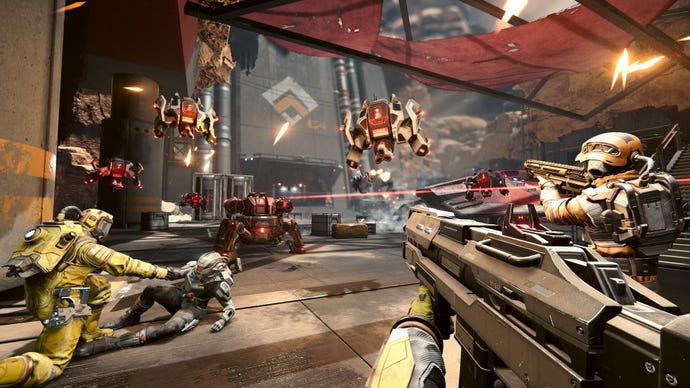
There’s no PvP, however, which partly reflects Keepsake’s limited resources. “If we have PvP, we have to make sure that for every shot, every bullet, the server confirms who did the most damage, blah blah blah, and prevent cheating,” Coulianos explained. “[Because we’re making] a co-op only game, we can focus on making it snappy and responsive. I shot the robot, I’m telling the server what happened, so it doesn’t have to double check anything.” Players may still hack Jump Ship to improve their odds, he adds, but Keepsake don’t have a problem with people bending the rules when they’re not in direct competition.
Image credit:Keepsake Games
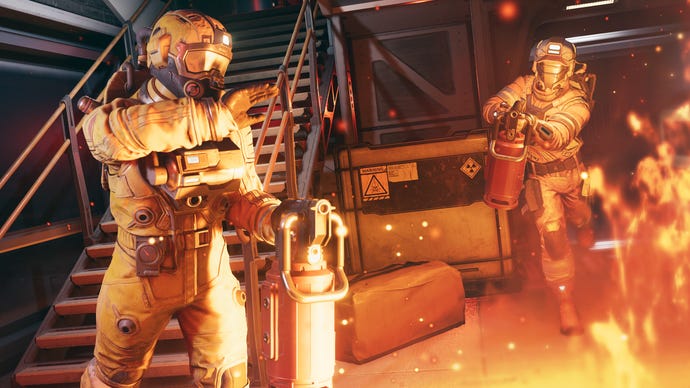
“So for example, you can have radiation leaks - suddenly, there’s a bunch of radioactive waste getting ejected into the ship, the generator is freaking out, and the feeling of that is, oh, my god, we’re about to die, wherever I’m standing there is this radiation indicator going up, and when it hits the max you’re down. So we have to take these radioactive rods and put them down the toilet or in a dispenser somewhere, one player has to do that, and the feeling is, of course, we’re about to die - but the ship itself isn’t going to die immediately.”
One of my great regrets, transcribing this interview, is that I forgot to ask whether you actually get to flush radioactive rods down the loo, or whether Coulianos was being whimsical. Given the potentially disastrous effects of making pizza, a bit of literal toilet humour would probably be right at home in Jump Space. We’ll find out for sure when the game launches intoSteam early accesslater this year.